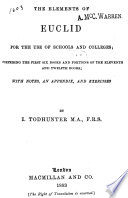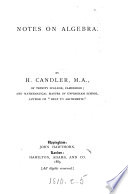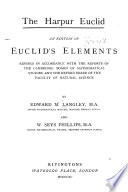 The first of four magnitudes is said to have the same ratio to the second, which the third has to the fourth, when any equimultiples whatsoever of the first and third being taken, and any equimultiples whatsoever of the second and fourth ; if the multiple... The first of four magnitudes is said to have the same ratio to the second, which the third has to the fourth, when any equimultiples whatsoever of the first and third being taken, and any equimultiples whatsoever of the second and fourth ; if the multiple...  Euclidian Geometry - Page 157by Francis Cuthbertson - 1874 - 349 pagesFull view Euclidian Geometry - Page 157by Francis Cuthbertson - 1874 - 349 pagesFull view - About this book
 | Euclid, Isaac Todhunter - Euclid's Elements - 1883 - 428 pages
...said to have a ratio to one another, when the less can be multiplied so as to exceed the other. 5. The first of four magnitudes is said to have the same ratio to the second, that the third has to the fourth, when any equimultiples whatever of the first and the third being... | |
 | Howard Candler - 1885 - 116 pages
...fourth, that is, д, l>, c, d are said to be proportionals if — = b а The geometrical definition is 2. The first of four magnitudes is said to have the same...the second which the third has to the fourth, when, any equimultiples whatever being taken of the ist and 3rd, and any equimultiples whatever of the 2nd... | |
 | William Steadman Aldis - Algebra - 1887 - 616 pages
...f3,ft This condition is evidently equivalent to the definition 5 of the Fifth Book of Euclid, viz.— The first of four magnitudes is said to have the same ratio to the second, that the third has to the fourth, when any equimultiples whatever of the first and third being taken,... | |
 | Edward Mann Langley, W. Seys Phillips - 1890 - 538 pages
...number of metres may make, a greater length can always be found containing an exact number of yards. 5. The first of four magnitudes is said to have the ' same ratio ' to the second that the third has to the fourth, when, any equimultiples whatever of the first and third being taken,... | |
 | Euclid, Micaiah John Muller Hill - Euclid's Elements - 1900 - 190 pages
...Art. 67. Def. 13. EUCLID'S TEST FOR EQUAL RATIOS. Euclid states this Test in the following manner: — The first of four magnitudes is said to have the same ratio to the second, as the third has to the fourth, when any equimultiples whatsoever of the first and third being taken,... | |
 | David Eugene Smith - Mathematics - 1902 - 418 pages
...Teaching. One has but to read the Euclidean definition of equal ratios to be assured of this fact : " The first of four magnitudes is said to have the same...the second, which the third has to the fourth, when any equimultiples whatsoever of the first and third being taken, and any equimultiples whatsoever of... | |
 | G. F. Burn - Geometry - 1903 - 272 pages
...is the equality of two ratios. Four quantities are therefore in true proportion when the first has the same ratio to the second which the third has to the fourth ; thus, since 3 : 6 and 1 : 2 are equal ratios, we have a true proportion in 3 : 6 : : 1 : 2 (read... | |
 | Joseph Battell - Force and energy - 1903 - 722 pages
...must contain 2, 3 X 3, or 9 times. See Axiom 6. PROPOSITION IV. ' If the first of four magnitudes has the same ratio to the second which the third has to the fourth, and if any equimultiple whatever is taken of the first and third, and any whatever of the second and... | |
 | ANZAAS (Association) - Science - 1905 - 782 pages
...geometrically as sound as Euclid's, and infinitely more natural. I need only quote it to enforce the point : " The first of four magnitudes is said to have the same...the former parts as the fourth does of the latter." If the ground were cleared by relegating Euclid's definition of proportion to a mathematical museum,... | |
 | Australasian Association for the Advancement of Science. Meeting - Science - 1905 - 786 pages
...geometrically as sound as Euclid's, and infinitely more natural. I need only quote it to enforce the point: " The first of four magnitudes is said to have the same...the former parts as the fourth does of the latter." If the ground were cleared by relegating Euclid's definition of proportion to a mathematical museum,... | |
| |